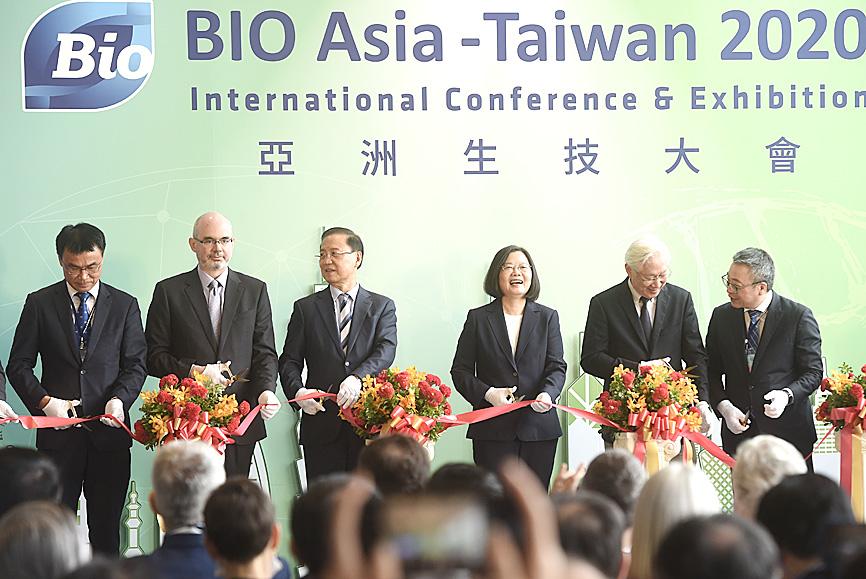During the opening ceremony of the BIO Asia-Taiwan Exhibition yesterday in Taipei, President Tsai Ing-wen (蔡英文) expressed the hope that advancements in Taiwan’s biotechnology industry would usher in major business opportunities from abroad, allowing the sector to reach NT$1 trillion (US$339.50 billion) in annual production.
Despite COVID-19, the annual biotech trade show attracted pharmaceutical and medical device companies from more than 500 nations, including the US, the UK, Australia, Switzerland and Malaysia.
The five-day exhibition is the first in-person international biotechnology trade show in Asia since the outbreak of COVID-19.

Photo: Chien Jung-fong, Taipei Times
Speaking at the opening ceremony, Tsai said that biotechnology is a crucial part of the “five plus two” innovative industries plan that she introduced during her first term, adding that she hopes the exhibition would be a platform for the nation to demonstrate innovativeness and accelerate the development of its biotech sector.
The nation would deregulate relevant laws to expedite the growth of the sector, she said.
The “five plus two” innovative industries plan refers to an initiative to develop an Asian equivalent of the US’ Silicon Valley, including biotech, green energy, industry 4.0, robotics, defense and aviation, as well as innovative agriculture and a circular economy.
Taiwan’s biomedical industry grew by 8.7 percent in annual revenue last year, a record high over the past few years, with the amount of capital invested reaching NT$55.1 billion, Tsai said, adding that digital medicine and precision medicine, two sectors that have shown great potential in recent years, are expected to grow significantly.
Cell therapy, regenerative medicine and genetic testing combined with big data analysis are also areas that have progressed a lot, while innovative medical devices, including nanomedical technology, are expected to receive more attention, she said.
New medicine development has also had breakthroughs, Tsai said, citing a licensing agreement signed in April by Taiwan’s Oneness Biotech Co Ltd and the Denmark-based Leo Pharma, a global leader in medical dermatology.
The agreement was signed to facilitate the development and introduction to the market of FB825, a drug candidate for novel atopic dermatitis and asthma, with an upfront payment to Oneness totaling US$530 million, the highest a Taiwanese company has ever received in such a deal.
Meanwhile, the National Biotechnology Research Park in collaboration with several multi-national pharmaceutical companies, accelerators and venture capital firms yesterday opened an accelerator hub for biomedical start-ups.
Speaking at the inauguration ceremony of the hub, former vice president Chen Chien-jen (陳建仁) said that the new facilities provide one-stop services to cultivate biomedical start-ups and has the potential to become the biggest accelerator hub in the field of biomedicine in the Asia-Pacific region.
The occupancy rate of biomedical companies at the park is 60 percent and the number is expected to reach 80 percent by the end of the year, Chen said, adding that growth at such a rate would be “beyond my imagination.”
Additional reporting by Chien Hui-ju

Beijing could eventually see a full amphibious invasion of Taiwan as the only "prudent" way to bring about unification, the US Department of Defense said in a newly released annual report to Congress. The Pentagon's "Annual Report to Congress: Military and Security Developments Involving the People's Republic of China 2025," was in many ways similar to last year’s report but reorganized the analysis of the options China has to take over Taiwan. Generally, according to the report, Chinese leaders view the People's Liberation Army's (PLA) capabilities for a Taiwan campaign as improving, but they remain uncertain about its readiness to successfully seize

Taiwan is getting a day off on Christmas for the first time in 25 years. The change comes after opposition parties passed a law earlier this year to add or restore five public holidays, including Constitution Day, which falls on today, Dec. 25. The day marks the 1947 adoption of the constitution of the Republic of China, as the government in Taipei is formally known. Back then the Chinese Nationalist Party (KMT) governed China from Nanjing. When the KMT, now an opposition party in Taiwan, passed the legislation on holidays, it said that they would help “commemorate the history of national development.” That

Trips for more than 100,000 international and domestic air travelers could be disrupted as China launches a military exercise around Taiwan today, Taiwan’s Civil Aviation Administration (CAA) said yesterday. The exercise could affect nearly 900 flights scheduled to enter the Taipei Flight Information Region (FIR) during the exercise window, it added. A notice issued by the Chinese Civil Aviation Administration showed there would be seven temporary zones around the Taiwan Strait which would be used for live-fire exercises, lasting from 8am to 6pm today. All aircraft are prohibited from entering during exercise, it says. Taipei FIR has 14 international air routes and

The Ministry of National Defense (MND) today released images of the military tracking China’s People's Liberation Army (PLA) movements during the latest round of Chinese drills around Taiwan. The PLA began "Justice Mission 2025" drills today, carrying out live-fire drills, simulated strikes on land and maritime targets, and exercises to blockade the nation's main ports. The exercises are to continue tomorrow, with the PLA announcing sea and air space restrictions for five zones around Taiwan for 10 hours starting from 8:30am. The ministry today released images showing a Chinese J-16 fighter jet tracked by a F-16V Block 20 jet and the